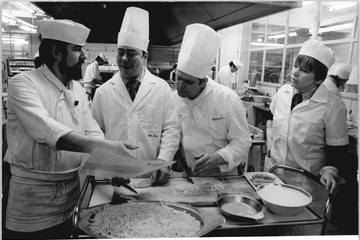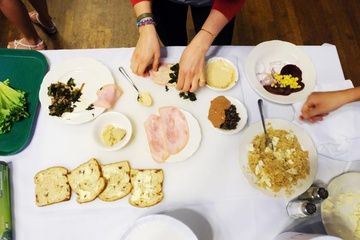It started in the spring semester of 2009 with a bet between House masters: which house could brew the best batch of beer before commencement? It became a Kirkland House fixture. Lead by advisor and Kirkland House tutor Luke Walczewski, the Brew Club is exactly what it sounds like.
Each week at their meetings, the members start a new batch of homebrewed beer. The brewing process itself centers on three main stages; “It’s a week of primary fermentation and a week of secondary fermentation; then, if you’re going to bottle it, it takes another two weeks in the bottles in order to carbonate,” Walczewski explains.
In the first stage, the ingredients are boiled together. “You put in hops, and you put in grain. The whole process from start to finish for the first step of it takes maybe two and a half to three hours by the time you do all the things you need to do,” says Walczewski. “Then, we let it sit and ferment for a week and then the yeast does its magic; it’s turning the sugars into alcohol and carbon dioxide.” In the next stage, secondary fermentation, the sediment that has collected on the bottom is siphoned off; the liquid is transferred to a different vessel, and then it’s left to sit for another week.
At that point, the trickiest stage of the brew process ensues: bottling. The club collects and recycles used bottles, sanitizing them thoroughly with a special solution and transferring the liquid into them. Since the brew is left flat after the initial and secondary stages of fermentation, the bottling process is also the carbonating stage. Walczewski explains that, to get carbonation, “You put a little more sugar in, and then you pour it into bottles and you cap it immediately.” With nowhere to go, the carbon dioxide carbonates the beer and—hey presto—you’ve got bubbles.
As luck would have it, beer brewing is a surprisingly affordable pastime. A starter kit goes for around $70. After that, each batch that the club produces is 5 gallons, or about 50 beers. At 30 dollars a round for supplies, it comes out to somewhere in the neighborhood of 60 cents a bottle—not too shabby for a decent brew.
Most of the ingredients are purchased at Modern Homebrew Emporium, located just west of Davis Square on Mass. Ave. The way Walczewski describes the store, it sounds like a grown-ups’ candy shop: “You go in and it’s basically giant tubs full of different kinds of grains,” he says. “They have, like, thirty different kinds of hops, and all these different strains of yeast.” The individual ingredients may sound less than delectable on their own, but as Walczewski puts it: “You can make all sorts of things.”
This breadth of possibilities is a sentiment that the Brew Club seems to have taken to heart. Some of the beers that the club has concocted in the past sound comfortably familiar—Belgian dubbels and Belgian tripels, ginger beer and holiday cheer ale. A few years ago, when the White House released the recipe for a beer they were brewing on site, the club made White House Honey Ale. Other brews, though, are more outlandish. Cherry chocolate porter. An IPA made with Solano peppers. Blueberry beer. Apricot. Juniper. Walczewski’s personal favorite is their Citra IPA. Brewed with special Citra hops, he refers to it as “kind of our signature beer.”
When asked for brewing advice, Walczewski offers, “Just try it. Don’t be nervous about what can go wrong,” adding, “The worst thing that happens is you make a beer that tastes bad, and you throw it all away. You’re not going to hurt anybody. Just make sure you’re following the law, and you’re 21, but it’s easy and it’s fun, and it’s cheap.”
Since students must be of legal age to participate, there is an almost complete turnover in Brew Club membership each year, but on the bright side, when students do get the opportunity to join, they also get to enjoy the drinks of their labor. “Drinking beer,” as Walczewski explains, “is an integral part of the beer making process.”
Kirkland House Holiday Cheer Ale Recipe
Courtesy of the Kirkland Brew Club
Ingredients:
GRAINS:
-1 lb Crystal 60
-2 oz Belgian Debittered Black Malt
MALT EXTRACT:
-3.3 lb Golden Light liquid
-3 lb Golden Light dry
HOPS:
-Bitterness (60): 1.5 oz Cluster
-Flavor: none
-Aroma (5): .5 oz Fuggle
YEAST STRAIN:
-Danstar Nottingham
OTHER INGREDIENTS:
-1 lb Honey
-1/2 tsp Irish Moss @ 15 min
-1 oz Cinnamon @ 10 min
-1 oz Sweet Orange Peel @ 10 min
-0.5 oz Ginger Root @ 10 min
Process:
Bring ~2 gallons of water to about 150 degrees Fahrenheit. Steep the grains. After 30 minutes, remove, and sparge.
Bring the wort to a boil, and then add the malt extract.
Bring the wort back to a boil and set a timer for 60 minutes. At the beginning of the boil, add the bitterness hops. With 15 minutes remaining in the boil, add the Irish Moss. With 10 minutes remaining in the boil, add the Cinnamon, Orange Peel, and Ginger Root. With 5 minutes remaining in the boil, add the aroma hops.
When the boil has finished, put the pot in an ice bath to bring down to ~70 degrees Fahrenheit. Once the wort has cooled, put it in your primary fermentation bucket, add water to reach a total of 5 gallons, and add the yeast.
After 1 week in primary fermentation, siphon to secondary. After 1 week in secondary fermentation, bottle. Wait about a month, then drink and enjoy.



